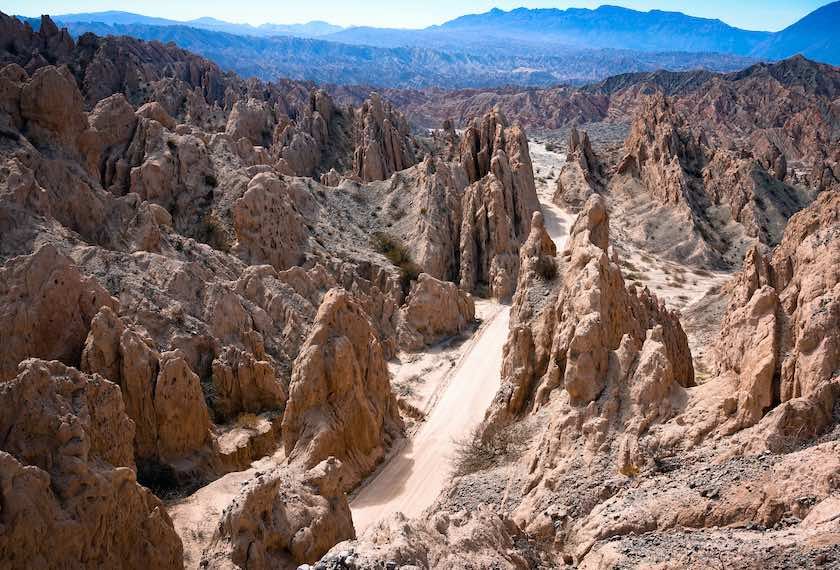
By Covitour - See b Road, Luly 2020
This incredible road trip takes you from Valle de Lerma to the Puna via the spectacular Quebrada del Toro. The route climbs 2,700 meters in 90 km, offering breathtaking views of the Andes, vibrant landscapes, and changing vegetation. Along the way, you'll pass through Santa Rosa de Tastil, with its ancient ruins, before reaching San Antonio de los Cobres, a mining town serving as an ideal base for Puna expeditions. The road becomes rugged, leading to a feeling of wildness and reaching an altitude of 4,600 meters. It's a unique adventure, taking you off the beaten track and allowing you to experience the region from a local perspective.
The Toro River gives its name to the narrow gorge that crosses gigantic mountains from the valleys to the highlands.
The route climbs 2,700 meters in 90 km, as it goes up, the majestic Andes rise on both sides, with intense green hills that turn red or blue, often wrapped in their characteristic clouds, and always immense and inspiring.
It is an overwhelming road where the landscapes change from the light greens of the valley and the dark greens of the jungle to the browns and ochers that dominate the atmosphere of the heights and the vegetation will transmute from the leafy yunga to the giant cacti and then to some stunted grasses.
We traveled through this ravine on our first trip to this region in the 1980s. On that occasion, we did it on the renowned “Tren de las Nubes” (Train to the Clouds). We had left very early from Salta, I remember how the powerful train climbed the mountain and snaked its way over steep slopes, along narrow valleys, crossed viaducts, approached or left the bottom of the ravine where the river runs, but always went up. We often saw the mountains glued to our windows, barely separated from our car. I always keep the memory of that first experience in the Andean World. The brochures of the time referred to a colossal feat of engineering and a technical feat, but the feeling that stuck with me the most was traveling on a toy train, with a zigzag set of wagons and its locomotive chugging at the head between immense mountains.
The Train to the Clouds no longer runs along the Quebrada del Toro, currently it only makes a testimonial route from San Antonio de los Cobres to the “Polvorilla” viaduct. Today we travel the 100 km of this incredible gorge in the comfort of our car. We stop, look, take photos, enjoy and continue.
Historically, the canyon was a route for goods and communications. It was used by the original inhabitants long before the arrival of the Incas. Later it was part of the "Chapaq Ñam", the Inca road system. The roads were an ever-present symbol of Inca power and authority and were instrumental in integrating the south of the empire with the center of power in Cusco. Then the Spaniards used it to strengthen the conquest and move caravans of cattle and mules from Salta to the Atacama Desert in Chile. Finally, in the mid-20th century, the emblematic rail C-14 followed its route, all along which the same rail of The Train to the Clouds.
The route passes through Santa Rosa de Tastil, located at 3,200m. This is a minimal town, barely inhabited by about 20 people; its relevance is in the ruins of an ancient citadel of a pre-Inca culture that was an important settlement in which it is estimated that more than 2,200 aborigines lived between the years 1336 and 1439. At the beginning of the 14th century, the Incas invaded the entire region and subdued all the local populations, forcing them to be part of the state tax system. The Incas transformed this place into an important administrative center.
The route continues to climb higher and higher until it crosses the mountain ranges that enclose the Puna, to finally lead to San Antonio de los Cobres, a mining town with small streets and low adobe houses, which is generally an ideal base for any expedition. In the Puna, since it has comfortable accommodations.
They enclose the Puna, to finally lead to San Antonio de los Cobres, a mining town with small streets and low adobe houses, which is generally the ideal base for any expedition in the Puna, since it has a comfortable inn.
From here, the road is gravel and sand and the environment conveys a feeling of wildness, almost inaccessible, in a short time, we will reach to 4,600 meters. In the "Abra del Chorrillo" point, and beyond the almost endless desert, the total remoteness and absolute desolation of the Puna and its immense plains.
We are passionate about making trips for individuals that go a little deeper. Traveling along scenic roads as this last story, beyond the reach of the beaten track, our tours invite you to see each destination through the eyes of the people who know it best: the locals who call it home.
